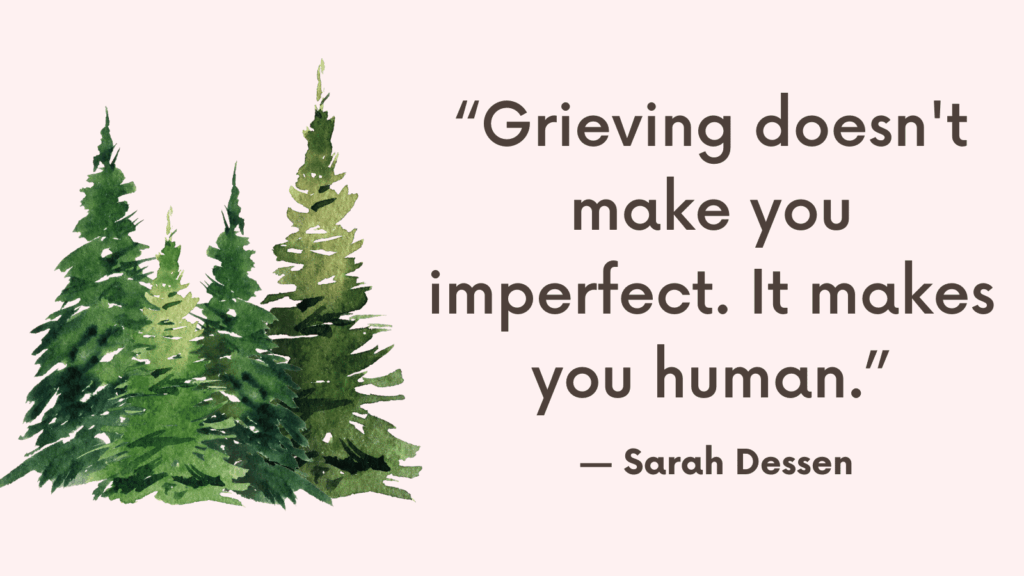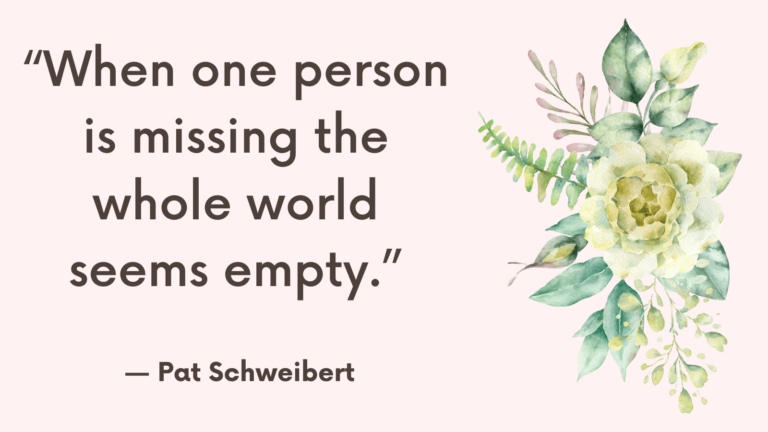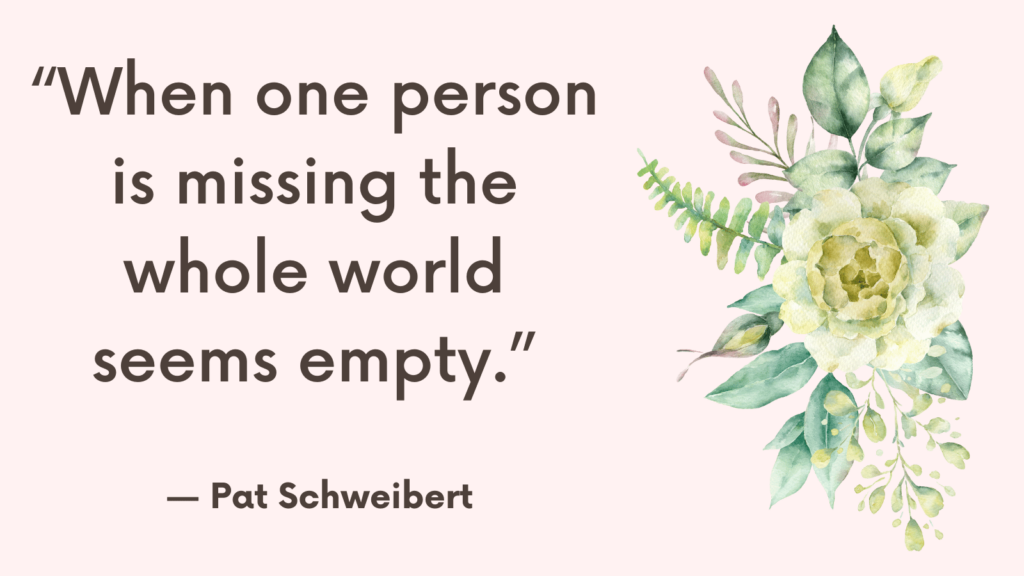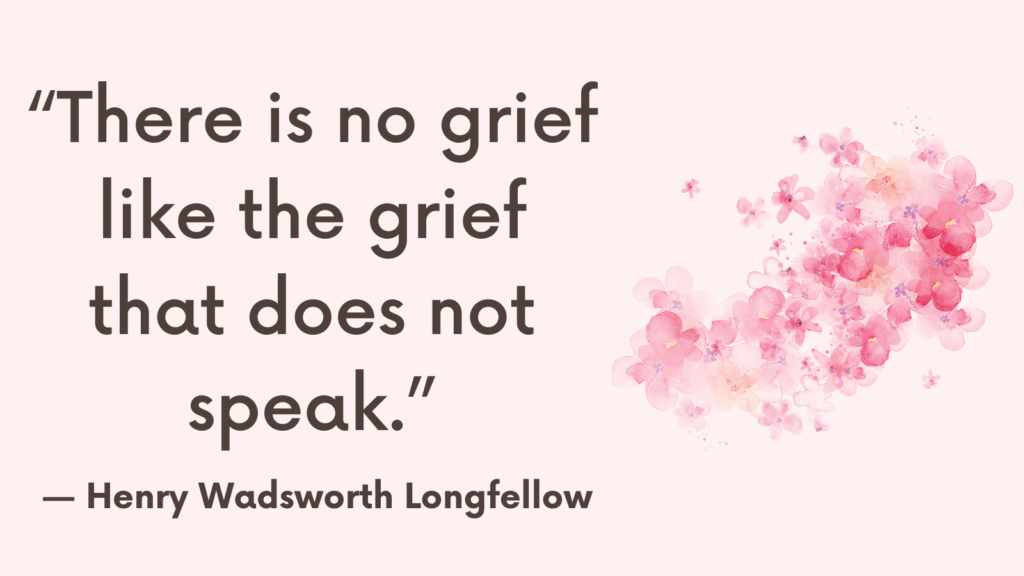In this post, you’ll learn all about ACT for grief and loss and how to use Acceptance Commitment Therapy ACT tools and skills to move forward with grief.
We all experience grief at some point.
Be it a loss of a loved one, or a loved pet, or a job, or a relationship.
Acceptance and commitment therapy helps you stay present while you move through grief.
Disclosure: Some of the links below are affiliate links. This means that, at zero cost to you, I will earn an affiliate commission if you click through the link and finalize a purchase.
It’s Not Just Death That We Grieve
When people think of grief, they usually think of the death of a loved one, but grief takes many forms.
1. Loss of an Important Relationship
Loss of (death or estrangement from) a close friend can feel just as painful as the loss of a spouse or family member.
For many people, the death of a beloved pet can be more profound than the loss of a human companion. Our pets are also a source of unconditional love and affection, and losing them can be painful.
2. Chronic and Terminal Illness
Chronic and terminal illnesses can result in a profound sense of loss.
Losing your health also means losing your sense of safety and peace, and sometimes your ability to live independently. You may also lose financial security, and friends who can’t handle your illness or face your death.
3. Change in Employment Status
The loss of a career or a business you founded can be significant. You don’t just lose economic security, you also lose the relationships you’ve formed and the sense of purpose you’ve had through that job.
4. Other Causes of Grief
Other forms of loss can seem less significant, but when experienced in a short time frame, they may lead to grief:
- Loss of a loved one to alcohol or drug use, military deployment, dementia or other serious illness
- Loss of a home to a disaster or because of financial troubles and loss of security through a home invasion
- Loss of the familiar after a big change in life, like graduating college, becoming a parent, moving to another country, a divorce
- Loss of sense of safety due to economic upheaval, and terrorism
Related: Best 21 Grief Journaling Prompts (+FREE Grief Worksheets PDF)
What Is ACT?
Acceptance and Commitment Therapy (ACT) is evidence-based, with hundreds of studies documenting its effectiveness.
ACT is a practical set of tools for developing psychological flexibility. It encourages us to mindfully embrace the things that trouble us.
When you stop fighting grief and make a commitment to take action, you increase your resilience and bounce back more quickly from grief. (*)
ACT uses six tools: values, committed action, acceptance, being present, cognitive defusion, and self-as-context.
If you are feeling suicidal, call the National Suicide Prevention Hotline at (800) 273-8255 or text TALK to 741-741. You can also call 9-1-1 or head to your nearest emergency room. Feeling suicidal is always an emergency, and you are worth saving.
ACT For Grief and Loss: 6 ACT Tools
Tool 1. Values
Values represent what matters to you most and what you choose to consider as meaningful.
Your values serve as a personal compass, helping you make the best choices for yourself.
Ignoring or acting contrary to your values, can cause feelings of unhappiness or unfulfillment.
Values are not goals that you eventually accomplish, like getting a job or getting married. They are guideposts for your life.
Download list of values PDF
One of the main reasons why some people struggle with people-pleasing is that they don’t have clear values.
The clearer your values, the less time you’ll spend trying to make other people happy and the more time you’ll spend doing things that bring you closer to your goals.
Practical Exercise – Clarify Your Values
Grab your journal or laptop and try to answer the following questions in as much detail as possible. Refrain from editing or judging what you write down.
- What were the most important things for you before your loss?
- What is the most important thing you want to accomplish in your life?
- What activities leave you feeling the happiest?
- What do you imagine your life looking like 5 years from now?
- How do you want other people to see you?
- What would you want to be remembered for after you die?
Read what you wrote and highlight keywords that describe personal characteristics and other values.
To explore your values more, answer the following questions:
Personal Growth: What are my strengths? What strengths would I like to have more of?
Relationships: What do I value about my relationship?
Health: What are the main characteristics of a physical and emotional healthy body?
Work: What beliefs about work do I have? Do I have work-life balance?
Wealth: If I had one million dollars today, what would I do with it?
Leisure: What activities bring me joy and pleasure?
Related: 72 Journal Prompts For Self-Discovery and Self Connection
How Clarifying Your Values Can Help You Move Forward?
After a loss, we’re usually tempted to act quickly, fix things, get out of pain. Without purpose and meaning, these actions are aimless and may cause more harm than good.
For example, after a breakup, you may start immediately dating again to avoid the pain. Without taking time to heal or reflect on what went wrong, you risk repeating the same mistakes.
Related: Dealing With a Breakup: How to Heal Properly and Love Yourself Again?
Values remind you of your purpose and help point you to your chosen direction. When doubting a particular action, ask yourself, “Is this action aligned with my values?” if not, don’t take it and think of an alternative one.
Practical Exercise: Prioritize Your Values
Take the list of values you identified earlier. If you have more than 5 values, try to combine related ones into one group or one value.
Rate each value on a scale from 0 to 10 with 0 being not important and 10 being highest priority.
Now rewrite your list, starting with the highest-priority values.
If you have more than one value with the same score, choose the one that you wrote down first.
Tool 2. Committed Action
You live a value-guided life through committed actions and goals.
Prioritizing your values and committing to taking action reduces anxiety and allows you to direct your energy and time toward the things that matter.
The next step is to take repeated committed action based on the values you’ve identified and prioritized.
Some of these actions will be physical (e.g. exercising and eating healthy food). Some of it will be emotional (e.g. allowing yourself to cry).
Related: 10 Proven Ways to Make Any Change Quick and Permanent
Your grief might be heavy and might leave you feeling less eager to do much of anything, but sometimes you just need to keep moving – you could still feel sad and do the things you know you need to do.
Review your values and make a commitment to take action on them. For example, you can make a commitment to “meditate for 20 minutes a day, regardless of how I feel.”
It’s important to make sure that your goals are realistic.
Practical Exercise: Take Committed Action
Grab your journal and write down activities and behaviors that can move you closer to your values.
Rate these actions on a scale from 1 to 10, with 1 being the easiest and 10 being the most difficult. Start with the easiest action and build up from there.
For example, if you value connection, then your committed action might include, spending at least 30 minutes of quality time with your loved ones, or calling one family member every day, or meeting up with your best friend at least once a week.
Commit to these actions, no matter what grief makes you feel. Allow yourself to grieve while doing the things you need to do.
Notice your emotions as you take the action. You might realize that despite getting an upset stomach before making a phone call, when it’s over a few minutes later, you feel a satisfying sense of accomplishment. Notice how despite not feeling like taking a walk, you end up feeling much better once you begin walking.
Why Committed Action Is Important To Move Forward?
Grief brings up feelings of hopelessness and depression that tell us that it’s better to just sit and do nothing.
The cost of behavioral avoidance, such as skipping activities, avoiding people, or numbing your feelings can be so high.
Your painful thoughts and feelings are not telling you the truth. They might be a valuable source of feedback, but you don’t have to make your decisions based on your emotions.
Committed action is the antidote to living in false beliefs. Each action you take in the right direction gives you momentum, making it much easier to take the next step.
Tool 3. Acceptance
Acceptance is a powerful antidote to suffering.
Acceptance means acknowledging difficult emotions, without judging them or judging yourself for experiencing them.
Acceptance means:
- Releasing the struggle
- Leaning in
- Allowing
- Opening up
- Being willing
When you stop judging your grief, you may realize that you’re not feeling what you’re actually feeling, but you believe you’re supposed to feel.
For example, if you believe the intensity of grief proves how deeply you loved the person you lost, you will act quite differently than someone who holds another set of beliefs.
4 Steps to Practice Acceptance
Acceptance includes the following steps:
1. Notice the feeling: Ask yourself “What am I feeling right now? Where do I feel it in my body?”
2. Normalize the feeling: Remind yourself that all humans experience similar feelings, and that it’s okay to feel the way you do, given what you’re going through.
3. Name the feeling mindfully: If you’re not familiar with naming your feelings, use the following list:
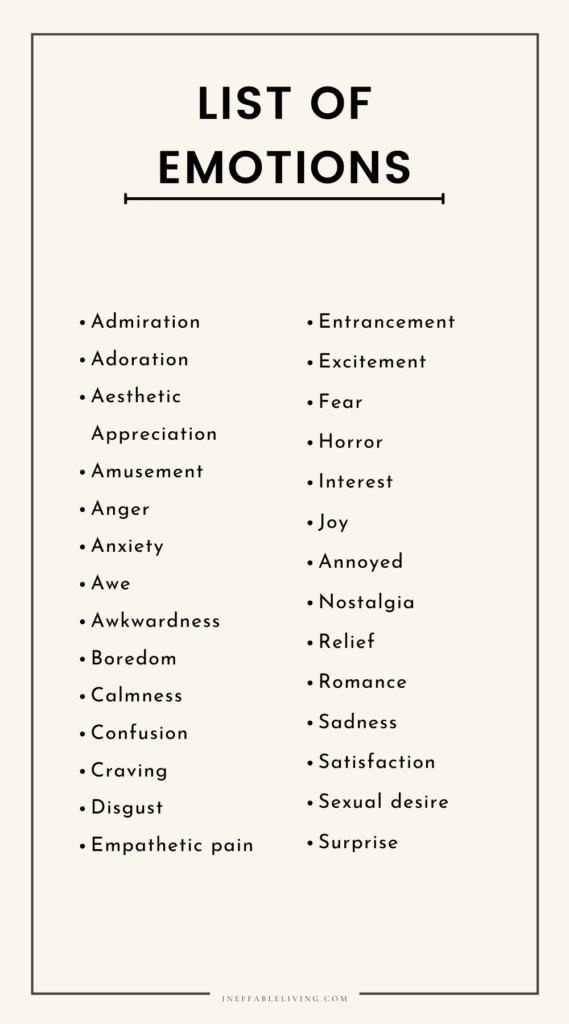
4. Allow the feeling to expand: Identify where you feel it in your body. Now, imagine the feeling getting bigger and bigger like a balloon you are blowing up, and see it get fill your entire body. Notice that you are able to handle the feeling despite it getting much bigger.
Acceptance requires being gentle and non-judgmental with ourselves. Recognize that you are a human being who is allowed to do things “wrong.”
Practical Exercise: Listen to What Your Grief Is Telling You
Resisting our emotions won’t make them go away. They get stuck in our minds and bodies and might come out in ugly ways, such as a breakdown.
You need to allow yourself to feel your emotions, not just to avoid getting stuck, but also because your emotions are a valuable source of feedback. Just like physical pain is your only way to know that something is wrong and need to be checked, your emotions tells you when something isn’t working and you need to change something.
Be curious and non-judgmental as you examine your sadness and answer the following questions:
- Where do you feel sadness in your body?
- How would you describe it? Is it tiny or huge, soft or hard, colorful or dark, hot or cold?
- How do you deal with your sadness? Express it? Hide it? Ignore it?
If you feel comfortable, write a conversation between you and your sadness. Ask your sadness directly what it has to tell you and what it wants you to do to alleviate it.
You can also answer these questions while meditating to allow yourself to receive this inner wisdom.
You can do the same for other emotions you identify like anger, guilt, shame, anxiety, etc.
Related: Suicide Grief Stages – How Are They Different? (+10-Step Guide To Grieve Suicide Loss)
How Accepting Your Grief Will Help?
Our difficult emotions are not the problem. It’s how we respond to them that can create suffering.
The process of struggling against your emotions is called “experiential avoidance.”
Trying to suppress, eliminate, or avoid your difficult emotions, despite the momentary relief it may provide, in the long run, it will only trigger or worsen the unpleasant symptoms and feelings you’re struggling with.
You can reach a point where the struggle against your pain causes more problems than the pain itself.
Accepting your grief doesn’t mean giving in to it or that you like it. It’s perfectly okay to hate how you’re feeling.
Accepting your grief, simply means that you acknowledge it as part of your life experience right now. You acknowledge that it’s there and you free your emotional resources to take effective action to manage your experience.
Meditation Exercise
1. Start by sitting in a comfortable position.
2. Check in with your body. Try to relax any tense areas.
3. Focus on your breath. Be curious about it and how it feels as you breathe in and out.
4. Once relaxed, start by recalling a recent memory that caused you distress. Make sure the pain is endurable, like a memory of an argument or feeling embarrassed.
5. Remember how you felt at that time. What emotions come up? Hurt? Fear? Sadness? Be curious about them.
6. Imagine that this feeling is being met with compassion as if you’re having a small child standing in front of you.
7. Now say goodbye to your memory and watch as it moves further and further away from you.
8. Reflect on how you feel and the sensations you feel in your body now.
9. Take a few minutes to journal about the experience.
Once you get comfortable dealing with less painful emotions and memories, gradually begin to tackle more difficult ones.
If you start to feel overwhelmed, open your eyes and focus on an object in front of you. Make it your anchor and give it your full attention. Breathe deeply until you feel calmer.
Tool 4. Being Present
Living in fast-paced culture has made it increasingly difficult to simply be present.
Being present may sound so simple. But more often than not, we are either living in the past regretting things that happened or in the future worrying about things that might happen. You might look like you’re present, but your mind is a thousand miles away.
This leads to feelings of anxiety and distress.
The best way to counteract these distractions is by slowing down and bringing more awareness to everyday activities, such as washing the dishes, showering, and even washing your hands.
Related: 6 Simple Ways to Practice Mindfulness Throughout The Day (and Find Your Inner Peace)
Mindfulness helps activate the parasympathetic nervous system (responsible for the body’s rest and digestion response). (1)
Mindfulness means paying attention to your internal and external experiences.
Internal experiences include your thoughts, feelings, memories, daydreams, and bodily sensations and movements, such as your heartbeat or breath.
External experiences include the five senses experience (the sounds you hear, the things you see and feel, the smells, and the taste in your mouth.)
Practical exercise: Be Present in Daily Activities
1. Choose an activity you do everyday and bring awareness to it, such as taking a shower.
2. Feel and listen to the water pouring against your skin.
3. Smell the shampoo you’re using.
4. Pay attention to visual details you don’t usually notice, such as the iridescence of the bubbles.
5. If your mind starts to wander, simply bring back your attention to what’s in front of you.
How Being Present Will Help?
Your life has more to it than grief.
Even though pain and sadness are a big part of your life right now, there is more to it – joy, pleasure, hope.
By being present you invite these other emotions to your experience and allow yourself to reengage with your life and keep moving forward.
Tool 5. Cognitive Defusion
“Cognitions” is just another name for your thoughts and “defusion” means separating yourself from these thoughts.
Cognitive defusion involves creating space between yourself and your thoughts and feelings so that you can discern which thoughts serve your well-being and deserve attention.
By creating a space between yourself and your thoughts and emotions, you begin to realize that you’re not your “loss or grief personified.” You stop seeing the world through the lens of grief and begin to see things in a more accurate way – “Just because I’m feeling sad, doesn’t mean life is terrible.”
Practical Exercise: Turn Down the Volume
1. Take your journal and start by writing down the self-talk and thoughts and statements in your mind right now.
2. Read each statement out loud. Use different tones for them: blaming, angry, frustrated.
3. Now use a normal, neutral tone and read the statements out loud again.
4. Lower your voice to a whisper and use a gentle, compassionate tone to read the statements out loud again.
5. Notice the change each time.
- What was it like to use different tones and levels of volume?
- Did the statements feel different as your tone of voice changed?
- Do your thoughts feel less fused and less true?
- Can you see how words are just words, not facts?
Related: Top 10 Common Examples of Cognitive Distortions – How To Challenge Them (+Worksheets PDF)
Tool 6. “The Observing Self”
Self-as-context, or “the observing self,” is a way of describing your thoughts, emotions, and experiences as an observer of yourself, rather than the embodiment of your thoughts and feelings.
Self-as-context is when you view yourself as the central character in a story. You can become an independent observer of your experiences.
For example, instead of saying “My nerves are tied up in knots,” you notice that you are having anxious thoughts and the physical symptoms of anxiety, without labeling these experiences as good or bad – It’s just what it is.
Practical Exercise: Self-Observation
Take a few minutes throughout the day to pause, close your eyes, and notice what’s going on in your mind and body.
Notice any thoughts and body sensations you are experiencing.
Grab your journal and take a few notes of these experiences.
What am I thinking right now?
What am I feeling emotionally?
What does my body feel like?
Write down your experience without judging it as right or wrong, good, or bad. Describe it as if you’re not the person experiencing them, but an observer.
How Defusion and “The Observing Self” Will Help
When we are fused with our thoughts and emotions, we are operating as what is called “the conceptualized self.”
By saying “I am depressed,” or, “I am anxious,” we conceptualize ourselves in such a way that filters what we allow ourselves to experience and we give ourselves a false identity. We convince ourselves that the thoughts now running through our heads are actually facts.
But just because you have a thought or are experiencing an emotion, doesn’t mean it’s the truth.
When you practice cognitive defusion and use the “observing self,” saying for example, “I experience feelings of anxiety or sadness,” you begin to make contact with your life in the present moment.
Rather than getting stuck responding to the stories that play on an endless loop in your mind, you allow yourself the freedom to take committed actions that align with your values.
Pro Tip: Write a Letter about Your Loss
Writing a letter to your loss will help you make peace with your loss and allow your grief to dissipate.
1. Write about the actual loss and what led up to it
2. Write about what has been different since your loss (Since I lost you, so much has been different . . .)
3. Write about why you need to move forward and how being stuck in interfering with your life (I am saying goodbye now because . . .)
4. Describe how accepting your loss and moving forward is making you feel (Saying goodbye makes me feel . . .)
5. Describe every regret, resentment, and appreciation you have around the person or thing you’ve lost (The best thing you gave me . . . You taught me . . . My most difficult memory is . . .)
6. Write down everything you wish the person you’ve lost to know and left unsaid (Something I want you to know . . .)
Related: How To Heal A Grieving Heart? +30 Activities That Will Help You Navigate Grief
Free Printable Worksheets For Grief (PDF)
Grief Books
FAQ
How Long Does Grief Last?
The duration of grief depends on a number of factors, namely the nature of your relationship, the circumstances of the death, the support systems, how well you usually cope with emotional pain and resources available to you, other things going on in your life, etc.
Time will heal, but time spent avoiding grief – keeping busy, traveling, or visiting relatives—will not help.
Related: Grief Is A Journey Not A Destination (& Other 12 Grief Lessons No One Talks About)
Can Grief Be a Mental Illness?
Although grieve is a natural and healthy response to loss, it can become unhealthy when the person grieving feels stuck in their grief.
Prolonged grief disorder
Studies show that 1 in 10 adults may experience prolonged grief (source)
The Statistical Manual of Mental Disorders, Fifth Edition, Text Revision (DSM-5-TR) added symptoms associated with prolonged grief disorder to its list of diagnostic criteria.
Prolonged grief disorder is now a formal diagnosis for those who have faced difficulty coping with loss for an extended period of time.
“I think these [clients] would generally get lumped into adjustment disorders or depression diagnoses,” said Karin Gepp, PsyD, a clinical psychologist in New York and Psych Central Advisory Board member, said in an email.
Diagnostic criteria
According to the DSM-5-TR, the diagnostic criteria for prolonged grief includes:
- A persistent grief response for more than 12 months (6 months for a child)
- Symptoms that significantly disrupt the person’s daily functioning
- Experiences that can’t be attributed to another condition, such as major depressive disorder (MDD) or post-traumatic stress disorder (PTSD)

References
- Portions of this article were adapted from the book Moving Through Grief, © 2019 by Gretchen Kubacky. All rights reserved.
- https://journals.sagepub.com/doi/full/10.1177/10541373211000175
- https://www.ncbi.nlm.nih.gov/pmc/articles/PMC6844541/
- https://www.nytimes.com/2021/04/22/well/what-happens-in-the-body-during-grief.html
- https://www.frontiersin.org/articles/10.3389/fpsyg.2018.00869/full
- https://www.apa.org/topics/families/grief
- https://www.npr.org/sections/health-shots/2021/12/20/1056741090/grief-loss-holiday-brain-healing
- https://www.sciencedirect.com/science/article/pii/S2212144720301940
- https://www.ncbi.nlm.nih.gov/pmc/articles/PMC5839459/
